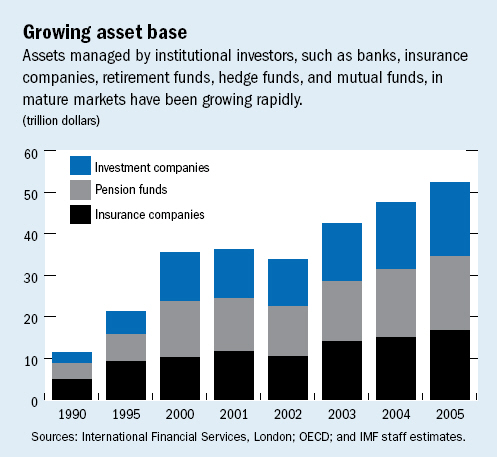
Typical street scene in Santa Ana, El Salvador. (Photo: iStock)
IMF Survey: Rising Diversity of Assets, Investors
May 28, 2007
- Speed of change, size of capital flows may temporarily distort prices
- Some investors have entered riskier areas where they have little experience
- Countries can reduce vulnerabilities by developing sound markets, instruments
As a result of the globalization of today's world financial markets, global capital flows are increasing rapidly.

Investment of pension fund assets in hedge funds is sign of increasing reliance on hedge funds to achieve higher returns (photo: Larry McKee/SCW)
Effects of Globalization
Asset classes and investor types are becoming more diverse. Many of these developments have been driven by a broadening investor base, financial liberalization, and technological innovations, enabling investors to diversify into new markets and new instruments, according to the IMF's most recent Global Financial Stability Report.
The diversity of assets, source countries, and investor types suggests that this form of globalization should support financial stability by distributing risk more widely. Long time horizons and lower leverage of institutional investors such as pension funds imply a greater capacity to ride out market volatility.
That said, the speed at which these changes are taking place and the sheer size of capital flows may temporarily distort prices in financial markets and create pockets of vulnerability. Indeed, cross-border capital flows have tripled over the past decade, to $6.4 trillion in 2005.
New frontiers of risk
In some emerging market countries, increased demand has outpaced the availability of domestic financial assets, leading to a sharp increase in asset prices, rapid credit growth, and currency appreciation. Also, some investors have been venturing down the "credit ladder," investing in riskier areas where they have little experience. With the growing role of leveraged investors such as hedge funds, asset prices have greater potential to overshoot during good times, increasing the probability of downside risks when financial conditions worsen.
Implementing structural policies to capitalize on the globalization of the investor base while fostering financial stability is the key challenge for many countries. The focus of prudential regulation and supervision needs to shift toward international risks conveyed through financial market instruments.
Countries can reduce vulnerabilities by developing sound markets and instruments and by providing an environment that enables market participants to share and transfer risks to those most able and willing to bear them. In addition, mechanisms to manage considerable gaps in global financial information flows can make oversight more effective.
Increased asset accumulation
Changes in demography, accounting, and regulatory frameworks and windfall gains accruing to commodity producers have led to increased asset accumulation and changes in asset allocations. Assets under management by mature market institutional investors have more than doubled over the past decade, amounting to about $53 trillion in 2005 (see chart).

Institutional investors in the United States account for about half of this amount, with continental Europe accounting for one-fourth, followed by Japan and the United Kingdom. Within conventional investment management, pension fund assets managed by institutional investors have expanded significantly. There has also been an increasing reliance on hedge funds as a vehicle to achieve higher returns, with pension fund assets being invested in hedge funds.
New sources of capital
Emerging market countries have become net exporters of capital and an important investor class in mature markets over the past five years. Their outflows mirror the U.S. external financing gap. This notable shift, which casts a spotlight on global payments imbalances, is driven primarily by the official sector in emerging markets, particularly central banks and sovereign wealth funds.
Gross official reserves have more than doubled since 2002, reaching nearly $5 trillion in September 2006. Governments of countries producing commodities have become large investors in financial instruments, particularly in bonds and equities, through sovereign wealth funds. Market estimates indicate that these funds manage more than $1.4 trillion.







